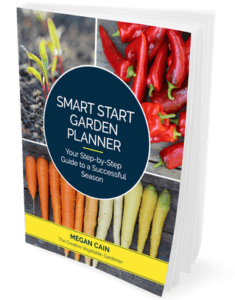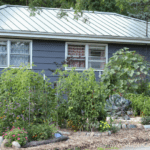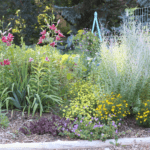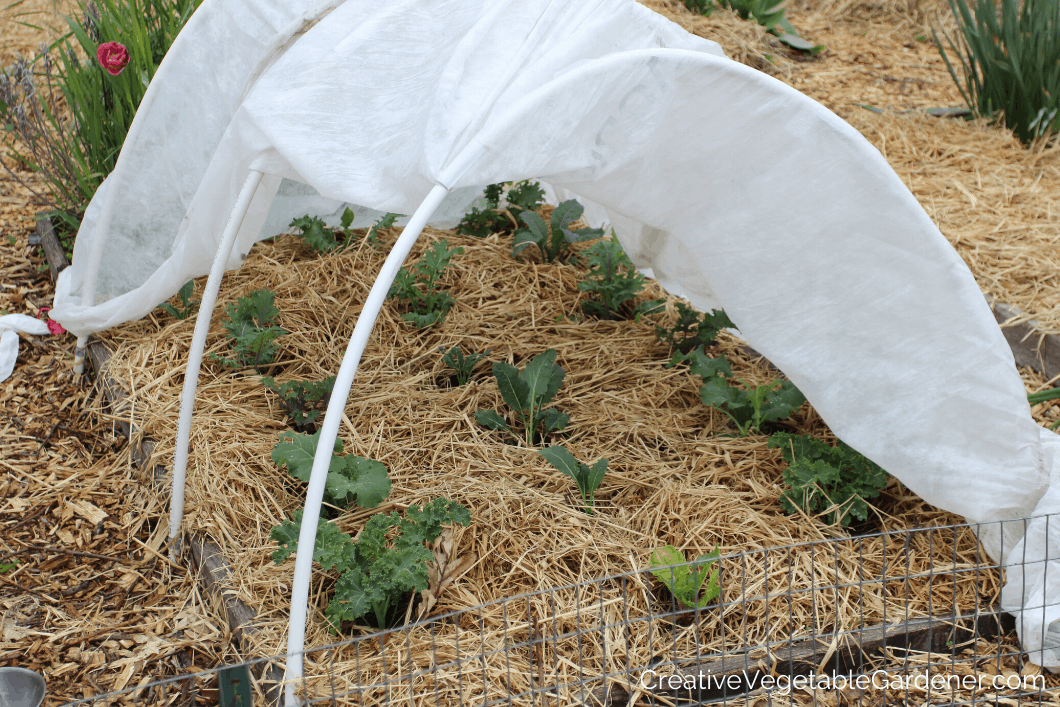 When we’re planting in our gardens in spring, what we should be doing for frost protection for plants is always top of mind. Especially if we look at the 10 day forecast and the temperatures dip a little too low for comfort. That’s a common spring occurrence where I live in chilly Wisconsin.
When we’re planting in our gardens in spring, what we should be doing for frost protection for plants is always top of mind. Especially if we look at the 10 day forecast and the temperatures dip a little too low for comfort. That’s a common spring occurrence where I live in chilly Wisconsin.
Row cover is my number one choice for frost protection every spring in my garden.
About 10 years ago I worked on an organic CSA farm and the farmer in charge exclaimed one day, “I don’t think I could run my farm in the spring without row cover.” During spring, every time we planted any seeds or plants, we immediately covered them in row cover.
Inevitably the row cover would be too short on some rows, so several plants wouldn’t get covered. In the weeks following, the difference between the plants that were under the row cover vs. those left out in the elements was remarkable!
The plants under the row cover were always bigger and more healthy looking, and the plants stuck outside were usually smaller and had more damage from frosts, insects, harsh weather and wind. This was all the convincing I needed to start using it in my own garden.
Now I say the same thing as my farmer friend, “I can’t imagine my spring garden without row cover!”
Frost protection for plants is this is the main reason I use it it in my garden in spring, but there are also many other benefits. Today I’m going to walk you through how to use it for frost protection, share the various additional reasons you might want to use row cover in spring, where to buy it, the other supplies you’ll need, and exactly when and how to use it.
If you’re looking for more information about using row cover in the fall, you can head on over to this article.
Let’s get started!
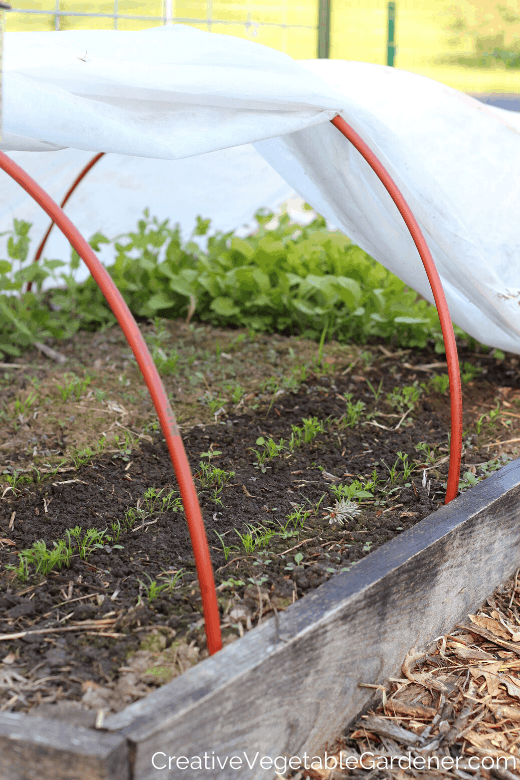
This post contains affiliate links.
What is Row Cover?
Row cover, also know as reemay or frost cloth, is a light white fabric, usually made of polypropylene or polyester, that can be placed over plants to protect them from low temperatures, insects and pests.
You can keep it over your plants day and night because light and water can both get through. There are different weights, lengths and widths, which we’ll get into later in the article.
It can be used in both spring and fall, but in this article we’re going to concentrate on using it in the spring to offer frost protection for plants.
When to Use Frost Protection for Plants
Using row cover in your garden is a great way to protect your plants from the wildly swinging temperatures in early and mid-spring.
You can get an idea of the general time of year when you can expect frosts to be occurring in your spring garden by looking up the average last frost date.
The best way to do this is to go to the website plantmaps.com and enter in your zip code.
The sites will display information for your area including your average first and last frost dates. Keep in mind that the actual day of the last frost can vary widely from year to year, especially with changing climate conditions.
Although my average last frost is usually around Mother’s Day, we have had frosts as late as Memorial Day Weekend. (I lost all of my peppers plants that weekend. True story!)
Your average last frost dates for your area are just a guide to help you narrow down when these frosts are most likely, but not guaranteed, to occur. You still need to be paying close attention to the weather forecast around these times, which we’ll talk more about later in this post.

Which Vegetables are Best for Covering in Row Cover
In the spring, you can (and should!) start planting cold tolerant vegetables before your average last frost. In fact, some of them, like arugula, cilantro, and spinach prefer being planted in early spring because they grow better in cooler weather.
Because they’re frost tolerant, it’s okay if they get caught in a nighttime frost. But, offering them a layer of frost protection with reemay will keep them extra safe and warm.
I generally start planting the following vegetables about four weeks before my average last frost (about mid-April in zone 5) and put a layer of row cover over most of them for frost protection and the added benefits we’ll talk about later in this article.
Arugula
Beets
Bok choy
Broccoli
Brussels sprouts
Cabbage
Carrots
Cauliflower
Celery
Cilantro
Collards
Dill
Kale
Kohlrabi
Leeks
Lettuce
Mustard
Onions – I plant so many onions I don’t cover them.
Peas
Parsley
Radishes
Salad Mix
Scallions
Spinach
Swiss Chard
Turnips
If you’re not sure exactly when to start planting the different vegetables in your garden in spring you can visit this article where I include a printable calendar you can customize for your garden zone: How to Grow More Food with a Custom Planting Schedule.
It’s a good idea at this time of year to keep your eye on the 10 day forecast before planting. Even though these vegetables are frost hardy, you should wait to plant them if a big snowstorm or extremely cold weather is in the forecast.
If my 10 day forecast lists temperatures in the upper 20’s and 30’s F I’ll go ahead and plant some of the frost tolerant vegetables on this list.
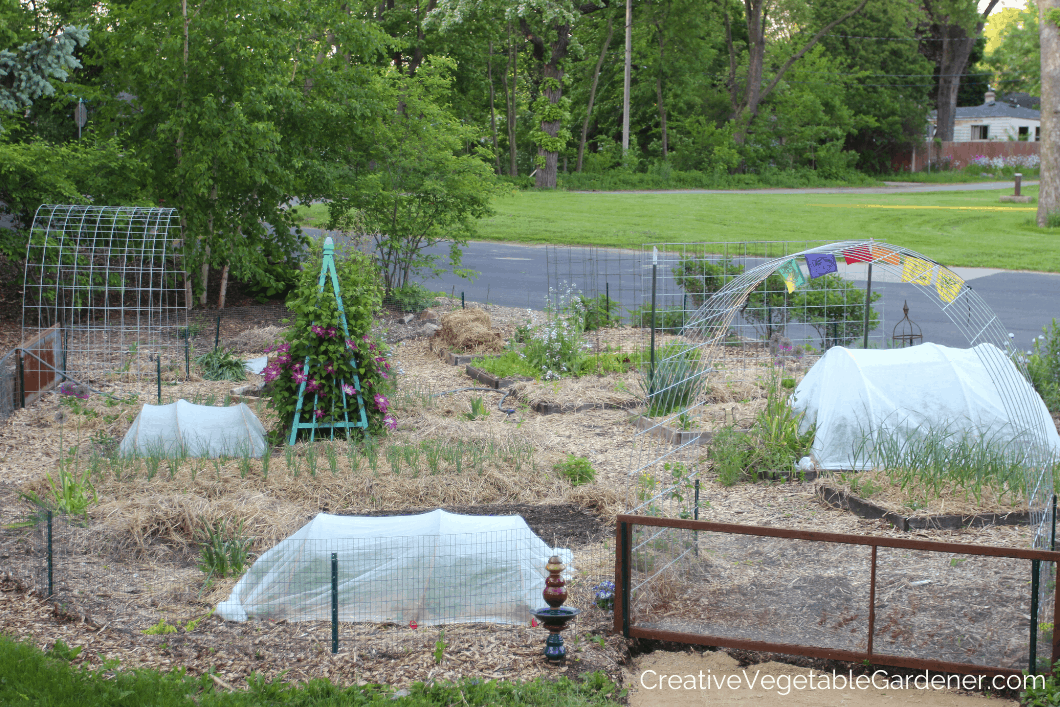
Should You Give Warm Weather Vegetables Frost Protection?
This is a question I get a lot when I’m talking and teaching about row cover. Ideally, you’re waiting until after your average last frost date to plant warm weather vegetables like basil, eggplant and tomatoes.
That means the nighttime temperatures should be warm enough that these plants won’t need protection. But, you may want to cover them with row cover for some of the other reasons we’ll talk about below.
Tips for Using Row Cover
With seedlings: In my garden after planting a seedling I will mulch it and then cover it with row cover. I don’t like to leave bare soil underneath row cover because the weeds love it under there as much as the vegetables. In this article and video about prepping spring garden beds I share exactly how I go about planting seeds and seedlings.
I like to use some kind of hoop to keep the row cover up off of the seedlings. If the fabric is touching the plants and there’s a hard frost the cold will transfer through the fabric to the seedlings. I talk about which hoops I use in the supplies section below.
With seeds: Immediately after planting seeds I cover the bed with row cover. Sometimes I use hoops and sometimes I don’t. I don’t mulch right away since I’m waiting for seeds to germinate. Once they’re up and have been growing for a few weeks I’ll mulch between the rows using hay or straw. Read all about vegetable garden mulch.
Watering: You can water right through the reemay. There’s no need to remove it.
How long can you leave the row cover on the plants?
If you’re using it on a crop that needs to be pollinated, such as eggplant or zucchini, you need to take it off when the plant is flowering. On other vegetables, it really depends on why I’m using it. If it’s just for frost protection, I’ll remove it when the date of my average last frost has past.
If it’s for insects or pests I may leave it on longer. I share some different scenarios in the added benefits section.
Harvesting: When it’s time to harvest the vegetables under the frost cloth simply remove a few of the pins and pull aside an area of the row cover for easy access.
Storage: To ensure a longer life, make sure you don’t leave your row cover out in the garden after you’re finished using it. Make sure it’s clean and dry before putting it away. I highly recommend storing it in a tub or box in your garage or garden shed when not in use. This helps it last for many years. I haven’t bought new row cover in over six years.

Other Benefits of Spring Row Cover Besides Frost Protection
Retains moisture
As soon as I direct seed a vegetable in spring I immediately cover it with row cover to coax along germination. Newly planted seeds need consistent moisture in order to germinate well and row cover traps in a little extra moisture under its cover, which can result in better and more even germination.
I’ll often remove the row cover from these garden beds when the seedlings are a few weeks old and I’m ready to mulch between the rows.
Traps in heat
One of the ways row cover offers frost protection to plants is that it keeps the plants it’s covering a few degrees warmer than the air temperature. In northern climates (like where I live in Wisconsin) the spring weather can be pretty cold during the days and nights. Plant growth responds to both heat and light, when you keep things a little warmer they grow more quickly.
Here’s an example of two different lacinato kale plants that were planted the same day.
One has been sitting outside of the row cover since day one and it’s looking a little beat up. It looks like a squirrel took a bite out of it. The other one has been protected underneath the row cover and it’s looking a lot bigger, healthier. It’s been a little bit more protected and a little warmer, so it’s grown faster.
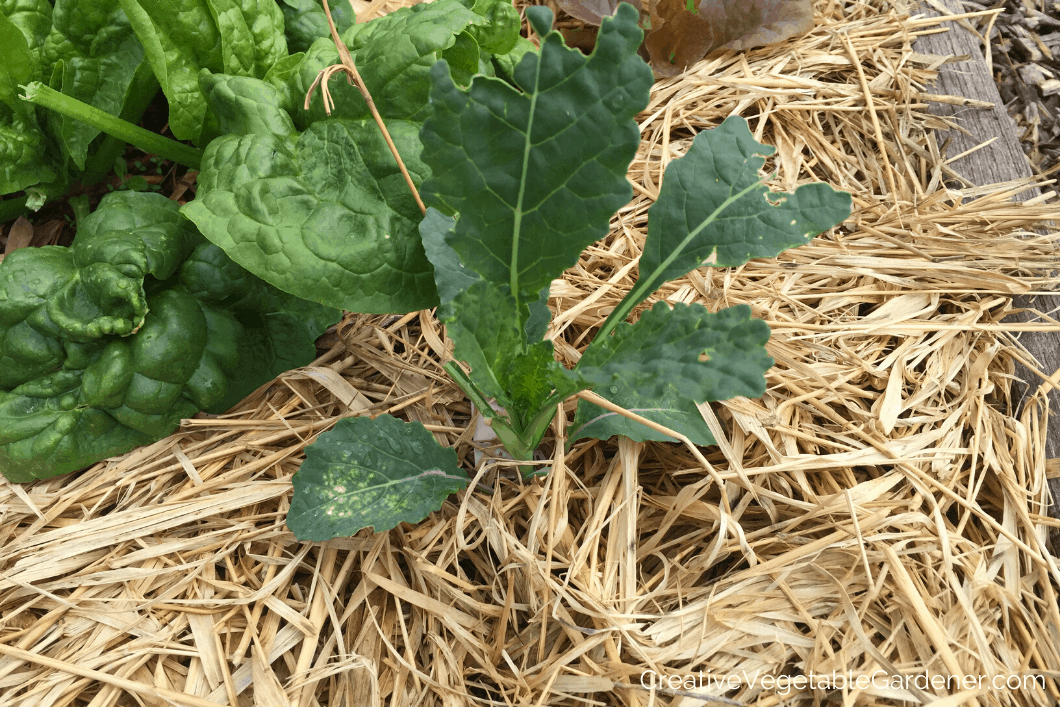
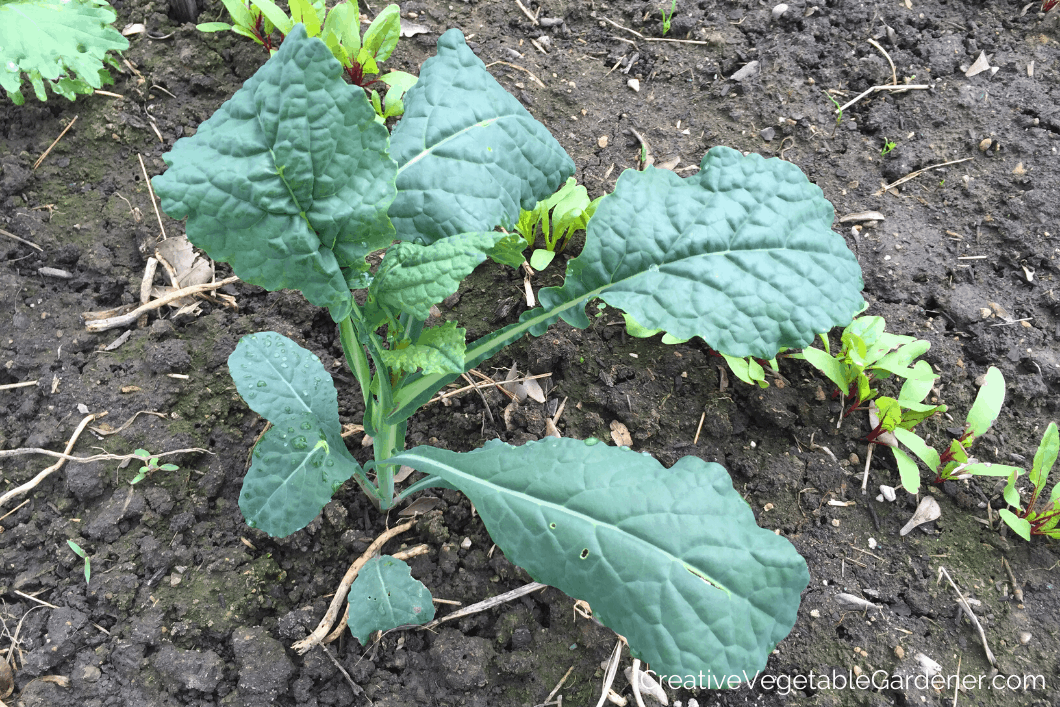
When the summer season approaches and the days and nights are warmer, I don’t feel like most of my plants need the extra heat provided by row cover. So, I’ll remove it all and put it into storage in my garage.
Protects from critters
I definitely recommend having a fence around your vegetable garden to protect your plants from animals like deer and rabbits. But, even with a fence, there are some critters like squirrels and chipmunks that aren’t deterred and can wreak havoc in your garden in spring.
This is definitely one of the reasons I use row cover in my garden when many of my plants and seedlings are young and tender. It prohibits squirrels from digging up newly germinated carrots and beets, and chipmunks from nibbling on little kale seedlings.
I find that once plants really get growing they’re less susceptible to damage from these animals.
But, in the past, in a garden where I didn’t have a fence, I’ve left row cover on carrots the entire season until harvest time, because each time I took it off the rabbits would start to eat the tops. I’ve even come out into my garden and seen a rabbit sticking its head in a piece of row cover that had a hole in it and eating what was underneath!
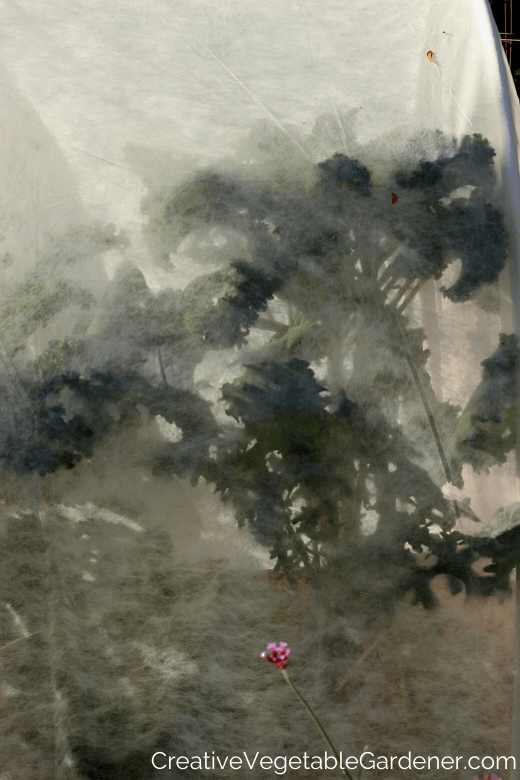
Insect protection
Depending on what insects you’re trying to protect your plants from you’ll use the row cover in two different ways. I have a lot of white cabbage butterflies in my garden that lay eggs on my kale plants, which eventually hatch into worms that eat the heck out of the leaves.
For many years I’ve used row cover as a physical barrier between my plants and the butterfly. Keeping them covered doesn’t allow them to lay their eggs on the plants – problem solved!
You need to install the row cover immediately after planting so the insect doesn’t have a chance to get started destroying the seedlings. I often leave the row cover on my kale until July or so when they’ve had a few months to grow undisturbed by the white cabbage butterfly.
Want to read more about white cabbage butterfly?
I’ve also used row cover to protect eggplant from flea beetles. They’re tiny black insects that jump around and eat holes in the leaves of vegetable plants. In the past my eggplant has gotten destroyed by them!
Last year I decided to replicate a technique I saw on the farm where I used to work, which is creating an impenetrable barrier with the row cover.
After planting my eggplant seedlings, I covered the bed in row cover and then shoveled soil around the entire perimeter. This worked like a charm! Not one flea beetle was able to attack my plants and I had the nicest looking plants ever!
I did have to remove the row cover when they were flowing so they could be pollinated, but by that time the flea beetles were mostly gone. Ha! Thwarted.
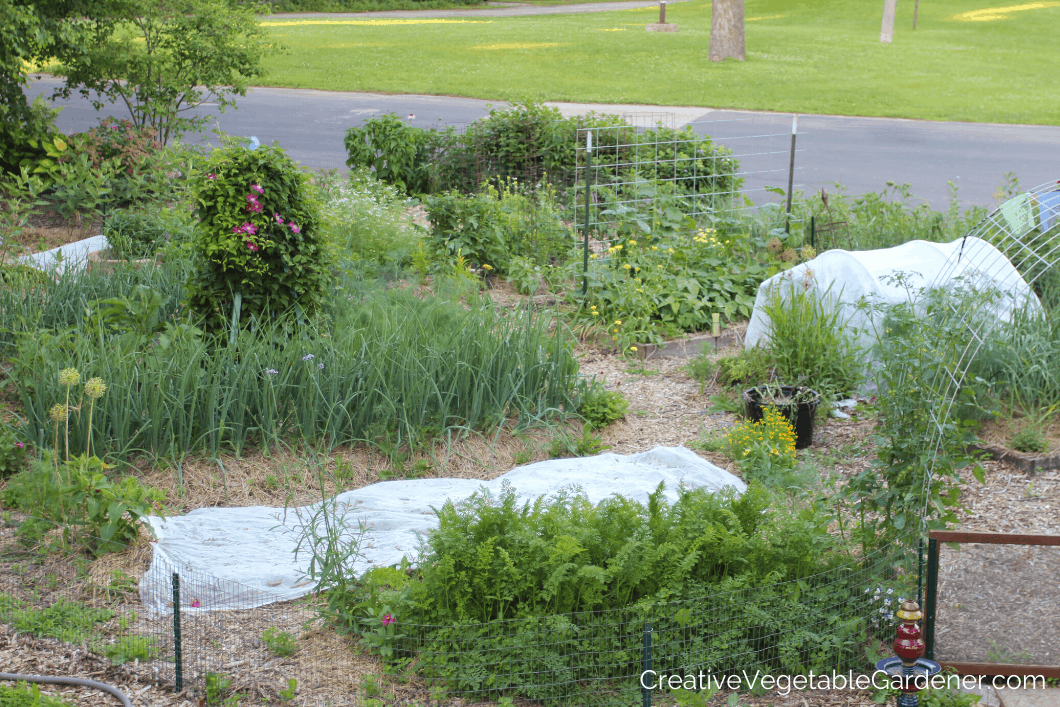
Where and What Kind to Buy
Now that you’re familiar with all of the amazing reasons to use row cover for frost protection for plants (and much more!), let’s talk about the different kinds and where to buy it.
Understanding the Different Types of Row Cover
Weight
There are different weights of row cover. The heavier they get the more temperature protection they provide, but the less light gets through. Less light isn’t a big deal in the winter when plant growth has stopped due to short days, but is more important in the spring when we want as much light as possible to get to the plants since they’re just starting to grow.
Keep this in mind when ordering. Think about when you’re going to use it. In the spring and fall? Then you might want more than one weight or to choose something in the middle.
Agribon-15 – used more for insect barrier than for frost protection for plants
Agribon-19 – protection down to 28 degrees F, light transmission 85%, this would be a good choice for spring and fall
Agribon-30 – protection down to 26 degrees F, light transmission 70% – good choice for mid- to late fall
Agribon-50 – protection down to 24 degrees F, light transmission 50% – for overwintering vegetables
Agribon-70 – protection below 24 degrees F, light transmission 30% – for overwintering vegetables
Length and Width
There are generally two different widths of row cover – 83 inches and 10 feet. You’ll need to measure your garden beds and make sure you’re ordering the correct width for your situation.
Another thing to consider is which vegetables you’re going to be covering. If it’s something that’s tall like kale, you’ll likely need the 10′ width. If it’s a shorter vegetable like spinach, 83″ is might be sufficient.
And if you’re using hoops or other supports, you’ll need to take that height into consideration as well.
This is a helpful note from Hudson Valley Seed Company’s website: You should order enough to cover the length of your row plus two times the height of your hoops (if using) plus about 3 feet extra for securing the ends.
The shortest length I’ve seen row cover sold is 25′. The most common lengths are 25′, 50′, 100′, 250′ and 500′. It’s easy to cut with scissors, so you could save some money by ordering a longer piece and then cutting it into the lengths you need.
Not all of my garden beds are the same size, so I always end up with various sized pieces of row cover.

Where to Buy Row Cover
You may be able to find row cover at your local garden center or nursery. You can check there first.
If you need to order it online, here’s where I’ve gotten it from:
Hudson Valley Seed Company – will cut it to length for you!
Other Supplies You Need
Supports
If you’re using row cover for frost protection for plants you need to make sure the fabric doesn’t touch the plants or the frost will be transferred right to the leaves.
This means you need some type of support to hold the row cover up over the plants.
Just like when choosing the width of your row cover, knowing what vegetables you’re planning to use it with will help you decide what kind of supports you need.
Here are some options.
Wire hoops: These are great for low-growing vegetables like cilantro, greens, beets, and turnips. You can buy ready made hoops from seed companies and they also come in various lengths.
These wire hoops from Hudson Valley Seed Company go well with 3-4 ft. wide beds and the 83″ wide frost cloth.
Johnny’s Selected seeds has more options for widths here.
You can also make your own wire supports. That’s what I did. I bought 9 gauge galvanized tension wire and cut it to the length I wanted using bolt cutters. It was super easy!
There are various options for hoop style plant supports on Amazon, like this one.
You can also create hoops using PVC, which is a great option for taller vegetables. I use this for my kale plants. I show you how to make them in this video.
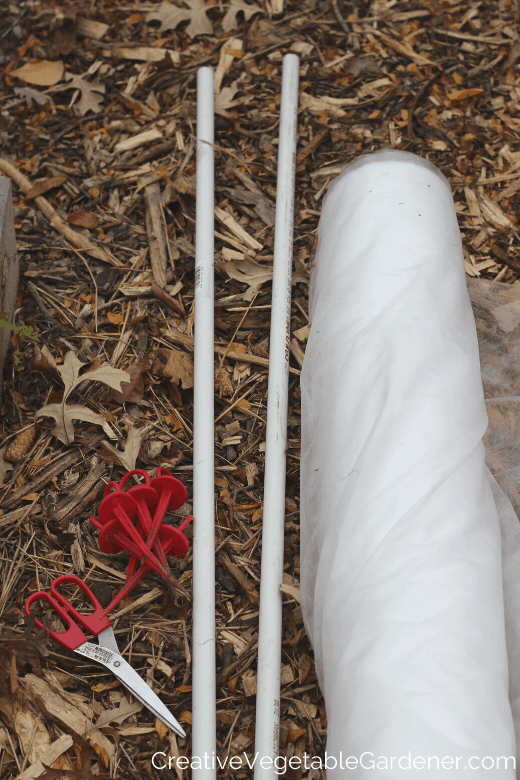
Pins
Once you get the supports in place and the row cover situated on top, you’ll need a way to secure it to the ground so it doesn’t blow around in the wind. This will also help keep critters out since they like to chow down on the vegetables tucked underneath.
Here are some options.
Metal Staples: These are a great inexpensive option for securing row cover. The only thing I don’t like is that they’re incredibly easy to lose in the garden because of their color. They tend to blend in to the beds and paths and I’ve lost MANY of them.
Red Pins: This is what I use in my garden. Because of the color it’s virtually impossible to lose them in your garden. My only complaint is that the red circular part on the top has a tendency to snap off after a lot of use (or when I step on it…). But, even without that piece the pins are still perfectly usable.
You can also use various pieces of wood, bricks, rocks, etc. I do that, too!
As I shared in the beginning of this article, I can’t imagine my spring garden without row cover. It’s helped me get earlier harvests, provides frost protection for plants in unpredictable weather, prevents critters from snacking on young seedlings and has even saved my plants from deadly insects.
If you’re looking for better results in your spring garden this season, I highly recommend adding row cover to you toolbox so you can offer frost protection for plants you’ve already spent a lot of time and energy starting, buying and planting in your garden!
Additional Resources for Spring Gardening
My book, Smart Start Garden Planner, is packed full of beautiful photos, tons of worksheets, and tips and techniques to create your own blueprint for what a successful season in your garden looks like.
MASTERCLASS
In each season of my Masterclass – Success In Every Season: Get Better Results From Your Garden All Year Long – we focus on exactly what you need to know to be successful. The seasons build upon one another (just like in your garden!) to create a complete toolkit of skills that will set you up for a more joyful gardening experience. Read more about it here.
GARDEN SUPPLIES: You can find my favorite garden tools, supplies, books, and more in my Amazon storefront.

